
19 Oct Key factors to maximize Container Throughput at Middle Eastern Ports
Since the 1970s, the Middle Eastern region has grown exponentially, and this growth is attributable to the global Oil and Gas demand. Also, in the upcoming years, these nations widely invested in various other industries too and now this region is the world’s epicentre for all reasons. Well, its geographic presence connecting the superpowers in North America and Europe with the developing as well as under-developed nations in the Asia Pacific and Africa.
With this potential geographic presence, Middle East transformed as an epicentre for maritime trade in the world. In fact, port authorities and local governments are increasing widely on infrastructure. Ports of Dubai, Abu Dhabi to name a few have wide level of automation which enables them to perform operations in a much faster pace.
Unlike the ports in other regions, truck congestion outside the port ecosystem isn’t a challenge. Rather achieving maximum throughput to stay competitive is valid in this region. But achieving maximum container throughput and have an edge over competitors is a much simpler target to achieve with a platform such as Port Community System (PCS).
How can a Port Community System facilitate maximum container throughput?
A Port Community System (PCS) is a web based platform that integrates disparate processes across the seaport ecosystem in a secured digital format. Shipping Lines, Container Yards, Forwarders/Consolidators, Transporters, Consignee and various other stakeholders are connected in a common portal to offer visibility of data and the entire operations across the ecosystem. Functions such as container tracking, vessel berthing, online document generation, electronic payments to name a few can be digitised with PCS. Here are some key factors which can assist in achieving maximum container throughput.
Consistency across operations
Functioning across the port ecosystem can vary from stakeholder to stakeholder. For example, a leading forwarder might follow a systematic approach compared to a forwarder with a small workforce. Whereas a Port Community System will ensure the KRAs for both remain the same in a feasible manner. The ultimate goal of a Port Community System is to have a systematic approach with automations and integrations.
Data accuracy and transparency
As the data exchange is in physical format across the ecosystem, accuracy takes backseat in various scenarios. Due to these inaccuracies, the forwarder needs to go back and forth to obtain accurate documentation. Reportedly, these iterations are causing unprecedented delays in the entire value chain. Moreover, the disparate nature of the legacy operation voids transparency. With a Port Community System in place, accurate documentation and transparent data sharing among all stakeholders is instantly enabled. Therefore, unprecedented delays and unwanted iterations in document correction can be voided.
Efficiency and timeliness
As discussed earlier, truck congestion isn’t a major issue at the land side function when it comes to Middle East. But delays in vessel berthing and lack of landside integrations are considered to be a major challenge in this region. In addition to this, time spent on studying regulatory norms too causes delays. A community platform enables maintenance of efficient timeline of operations and integrates port side and land side operations quite diligently. Processes which will other take hours will get completed in minutes or a lesser time. Also, regulatory guidelines come in specific parameter formats.

